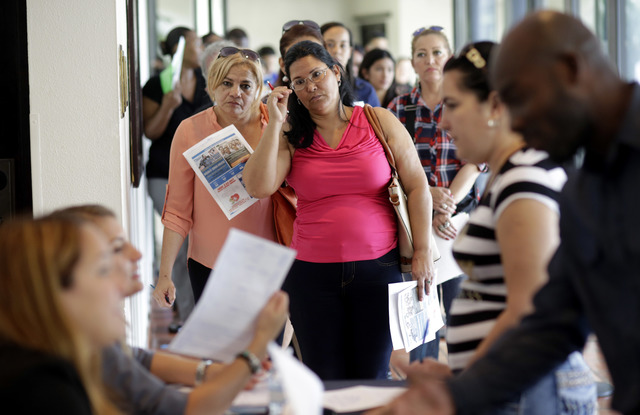WASHINGTON — Years of steady job gains have finally begun to benefit a wider range of Americans, including those with less education and in lower-paying jobs. ADVERTISING WASHINGTON — Years of steady job gains have finally begun to benefit a
WASHINGTON — Years of steady job gains have finally begun to benefit a wider range of Americans, including those with less education and in lower-paying jobs.
A second straight month of robust hiring — 255,000 jobs added in July — pointed to employer confidence that suggested the economy is powering through a slump that struck early this year. The unemployment rate remained a low 4.9 percent, the Labor Department said Friday.
Hiring has been solid for six years, but for most of that time there were caveats: Average hourly pay was stagnant. And millions were no longer either working or looking for work, leaving a smaller proportion of adults in the labor force.
Evidence is emerging that those long-running weak spots are finally improving. Many businesses are offering higher pay to attract workers as competition to fill jobs heats up. Average pay is up 2.6 percent from a year ago — matching the best 12-month gain since the Great Recession ended in 2009 and comfortably above inflation of just 1 percent.
The resilient job market is encouraging more Americans to begin looking for a job — a key trend that helps offset a drag from the growing retirements of aging baby boomers.
Taken together, the two trends suggest that the economic recovery, now seven years old, is finally benefiting a broad spectrum of the population.
Economists at Goldman Sachs have found that pay for workers earning less than $12.50 an hour has risen 4 percent in the past year, more than for any other income group. Those earning from $12.50 to $20 an hour have received the next-biggest increase, at just above 3 percent. Higher minimum wages may be bumping up pay for workers further above the federal minimum of $7.25.
“Wage growth figures indicate that the tide is turning,” said Douglas Holtz-Eakin, a former director of the Congressional Budget Office and president of the conservative American Action Forum.
Stock investors seemed pleased by Friday’s job figures, which raised hopes for the economy without seeming to compel the Federal Reserve to resume raising interest rates soon. The Dow Jones industrial average closed up 1 percent, and the Standard &Poor’s 500 index and the Nasdaq composite both set record highs. Many Fed watchers think the central bank will raise rates later this year but probably not before December.
The jobs report also suggested that employers were unfazed by either Britain’s late-June vote to quit the European Union or the U.S. economy’s tepid growth in the first half of the year: Just 1 percent at an annual rate. Most analysts expect the solid hiring to help fuel an economic rebound in the second half of this year.
Consumers, who have driven the economy’s post-recession expansion, ramped up spending in the April-June quarter at the second-fastest pace since the recession. Their spending, though, has been offset by a slowdown in business spending on machinery and equipment.
The economy’s average annual growth rate since the recession ended in June 2009 is just over 2 percent, the slowest since the 1930s. But job growth — the backbone of the economy — has fared much better: 2014 and 2015 notched the fastest two-year hiring gains since the late 1990s.
Part of the disparity is explained by slow growth in worker efficiency since the recession ended. Stronger hiring amid a weak expansion suggests that the economy has grown less productive, with workers delivering less output per hour.
Many of the disparities that have fueled voter anger this election season remain. Just 54 percent of Americans with only high school degrees have jobs, compared with 72 percent of those with college or postgraduate degrees.
Still, minimum wage increases and competition for workers are elevating pay in many industries, including those with heavy concentrations of low- and middle-income jobs. Average wages in the leisure and hospitality industry, made up mostly of hotels and restaurants, rose in July from a year ago by 4.1 percent. That matches June’s showing, the best in eight years.
Construction firms, which are scrambling for workers to meet demand for new homes, are paying 3.5 percent higher than a year ago. That’s the biggest gain in nearly six years.
Jesse Singh, CEO of Chicago-based CPG Building Products, said his firm has had to raise pay 10 percent to 20 percent and ramp up recruiting to find the workers needed to staff its two factories in Pennsylvania and Ohio. Consumer confidence is boosting sales of his company’s decking, trim and other products, Singh said.
“They feel comfortable enough to move forward with projects,” he said of American homeowners.
Women have been receiving a solid majority of the new jobs this year, boosted by robust hiring in health care and education. Through July, 78 percent of the 1.3 million jobs added have gone to women.
Americans with less than a high school degree are also coming back into the job market, likely in response to rising wages in lower-skilled sectors. Forty-four percent of people without high school degrees have jobs — the highest proportion since July 2007, before the recession began.
“It certainly is encouraging,” said Diane Swonk, founder of DSEconomics. “But is it enough to derail the anger we’re seeing this election season? No.”



